15 September 2020
Making the most of what we have learned about teaching thinking in the regular classroom to bring out the best in our students. Robert J. Swartz
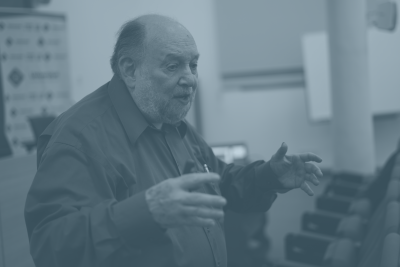
Robert Swartz has a PhD in Philosophy from Harvard University and is the creator, along with Sandra Parks, of the Thinking Based Learning (TBL) methodology, which replaces memory-based teaching with active thinking.
He has worked with teachers, schools and universities internationally on projects of teacher development, curriculum restructuring and education through critical and creative thinking into content teaching. He is also a member of the organizing committee of the International Conference on Thinking (ICOT).
By Robert J. Swartz
Over the past 25 years teachers in the USA, and more recently elsewhere, have been exposed to a wide variety of instructional techniques aimed at helping to improve the thinking abilities and practices of our students. Often these have come integrated into their own set of materials. Others have been based on a wide range of educational research and promoted on their own for use in the regular classroom. Cooperative learning, teaching for metacognition, the use of higher-order questions, and providing ample wait time for student responses are examples of the latter. “Mediated learning”, “lateral thinking”, and “philosophical enquiry” are examples of the former.
However, more and more, and through a process of extraction, refinement, combination, and transplantation, systematic instructional frameworks for teaching thinking have been developed which infuse many of these techniques into standard content instruction, making curricular content the subject matter that students are prompted to engage with using of these techniques in organized programs of instruction. This has happened in history programs and science programs especially, but it has gradually been a phenomenon that has found its way into almost every level of K – 12 (and even college) education.
Strategies for thinking skills and important habits of mind are made explicit, students then use these to think about important elements of curricular content, and a metacognitive layer is woven throughout.
The most sophisticated of these attempts, and the ones that show up in the research as the most effective, combine many of these techniques and strategies within a rich multi-faceted educational framework using the model of direct instruction as a delivery technique for the thinking skills and mental habits taught. Strategies for thinking skills and important habits of mind are made explicit, students then use these to think about important elements of curricular content, and a metacognitive layer is woven throughout. This model has now been refined through considerable instructional practice in a very large variety of classrooms.
In this article I report on a rich, and representative example of such infusion of instruction in skillful thinking into standard content instruction. By “skillful thinking” I mean the use of thinking-task appropriate thinking skills, enhanced by appropriate habits of mind, and directed by the thinker’s own sense of what types of thinking are called for. This has been the main focus of my own work in this field over the past 25 years. I have observed examples of this type of instruction again and again over this period. And I have seen the same result again and again. This process of filtration, refinement, and adaptation of techniques for teaching students in ways that improve the quality of their thinking infused into standard content instruction has yielded not only a coherent set of practices that do improve student thinking, but practices that also dramatically enhance their content understanding and learning. This is what I call “thinking based learning.” To me, this is education as it should be.
Examples of this type of instruction can reveal the classroom practices that lead to thinking-based learning. So let’s now go back in time a bit and turn to the classroom of Rita Hagevik in a middle school classroom in an urban middle school in Raleigh, North Carolina, to look at just such an example.

This process of filtering, refinement and adaptation techniques for teaching students to improve the quality of their thinking has resulted in practices that significantly improve their understanding and learning of content.
Infusing direct instruction in skillful thinking into content. Instruction
1. Introducing students to thinking skills and habits of mind
Rita Hagevik’s 7th grade science class has been studying how the energy used throughout the world is derived from various natural sources. Their textbooks outline the basics: how dammed up rivers produce water flows that run turbines that produce electricity, how nuclear power plants use heat from controlled nuclear reactions to heat water to produce steam that similarly drives turbines, and, of course, how crude oil far beneath the Earth’s surface is drawn out in wells, refined, and converted to burnable oil and gasoline.
But Ms Hagevik is not happy with this. The world faces an energy crisis and not everyone is pleased with the use of some of these sources of energy. This has created often heated conflicts. Just reading their textbooks does not convey any of this to these students who will be growing up in a world in which hard choices will have to be made by many people about these issues.
Ms Hagevik has, at the same time, been embarking on a project that has led to considerable revision of the way she carries out instruction in her classroom. Stimulated by various staff-development opportunities provided her in her school district, she has been trying to help her students develop important thinking skills and mental habits that will make her students better critical and creative thinkers. She has adopted an approach which she has observed other teachers embrace with great success – the infusion of instruction in skillful thinking into standard content instruction. And into this she has worked many of the techniques that I have referred to above.
Ms Hagevik’s concerns about what her students are learning about energy have now led her to think of this instructional context as one that is also ripe for restructuring in order to allow her to teach her students a number of additional thinking skills that she thinks will better prepare them for the challenges they will all face about energy as they get older – even if the challenge is one in the voting booth about who to vote for among candidates that have different views about energy in this country. And indeed, she thinks of this not as just about energy – these lessons will arm her students with skills that they can use in a tremendous number of other contexts that also will challenge them to so some good careful thinking.
Ms Hagevik has already introduced her students to a number of strategies for engaging in certain kinds of thinking skillfully that are very important to master. For example, she has taught them to think about parts of a whole object by considering, in addition to the traditional question “What are the parts of this object?”, what the function of each of the parts is and how they work together to make the whole operate as it does. This, she feels, is really what a thinking skill is: it involves engaging in a type of thinking like thinking about the parts of a whole skillfully by following a procedure that focuses attention in ways that lead to a richer and deeper engagement with content. She operationalizes this by teaching her students to ask and answer a series of prompting questions reflected in this “thinking strategy map” – questions that are designed to guide their thinking when they are thinking about parts of a whole:
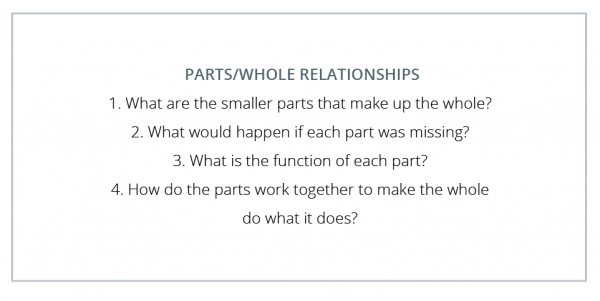
The use of this thinking strategy has, she has observed, deepened and enriched her students’ understanding of various wholes that they study – from whole cells to whole ecosystems. Other teachers have found the same result when they apply this to wholes like stories and novels, governments, geometrical structures, and even sentences in grammar. She is now convinced that she can broaden the range of the skillful thinking they can do by also teaching them a strategy for skillful decision making, and that when she does this if she makes the content focus energy sources this will similarly deepen and enrich their understanding not only of energy sources but will help them to become aware of the energy crisis we face and its ramifications in the world in which they live.
She is at a point where she has just said to her students: “I want you to imagine that you have been appointed by the government of the United States to be a member of a special committee. Our government is concerned with the availability of energy to serve our needs and wants to review the energy policy of this country. Up to now oil – and fossil fuels in general – has been the dominant energy source by far in this country. But they are concerned about claims made by scientists that petroleum reserves are being rapidly depleted, and that our reliance on oil has caused various nasty consequences, like pollution of the air, and even wars. So your committee has been asked to gather as much relevant data as you can to make a recommendation about what should be our dominant energy source over the next 25 years. Should we continue to rely on oil, or should we shift to some other energy source?”
She is now convinced that she can broaden the range of the skillful thinking they can do by also teaching them a strategy for skillful decision making.

She continues: “I want you all to engage with this issue as if you are a member of this committee. And as you do that I’d like you to use the strategy we just developed for skillful decision making.” What she means by “the strategy for skillful decision making” is this question strategy:
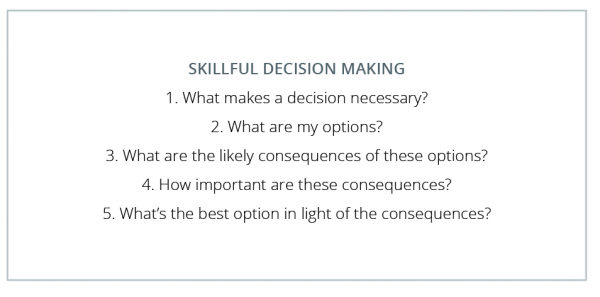
Notice that Ms Hagevik does not fall into the trap that many teachers do and simply ask the students to decide which energy source would be best for their country. This invites students to make quick, if not impulsive decisions – decisions that may express their opinions but that may not be based on careful thinking at all. This radio talk show paradigm – a paradigm also promoted by much advertising they are exposed to which often presents one quick and appealing side of a case and then tries to induce viewers to act on this through the use of compelling and appealing images – is not a good one for teaching to help improve students’ thinking. Rather, Ms Hagevik has taken the time to work with the students to make this strategy for careful and skillful decision making explicit, and then sets as a ground-rule for this activity that they use it in an organized way. But she realizes that just saying this is not enough. This is the first time her students have been exposed to this strategy, and old habits don’t leave us so easily, so she continues the lesson by actually guiding them through it. Lets see how she does that.
Infusing direct instruction in skillful thinking into content instruction
2. Prompting active student thinking about curricular content
Overview
Ms Hagevik’s approach to prompting her students to use skillful decision making to think about energy and energy sources involves three basic ingredients. These all serve to shift the center of gravity in her classroom away from a teacher centered model to an active student-centered model. She (1) breaks the students into “collaborative thinking groups” each with specific thinking tasks that contribute to the overall process, she (2) provides them with various graphics that serve as reflection and recording devices for their thinking, and (3) she provides oral guidance for them as they work through the thinking map for skillful decision making – she says things like, “Let’s work on the question about options now – what options do we have with regard to sources of energy?”. This classroom engagement by the students in skillful decision making is, therefore, highly scaffolded and focused. This has become one of the norms in Ms Hagevik’s classroom in starting instruction in a specific thinking skill. This detailed and explicit guidance is, in fact, no different from good instructional practice in teaching students to develop any skill.
Using a Graphic Organizer
So, after some open discussion with the class about what gives rise to a need for such a decision, she asks the students to engage in open brainstorming in their groups to get out on the table what options this country might have for energy sources. She asks the students to work together in their groups and record their ideas on a simple graphic organizer: a standard T-bar diagram. On the left is a column marked “Options”. It looks like this:
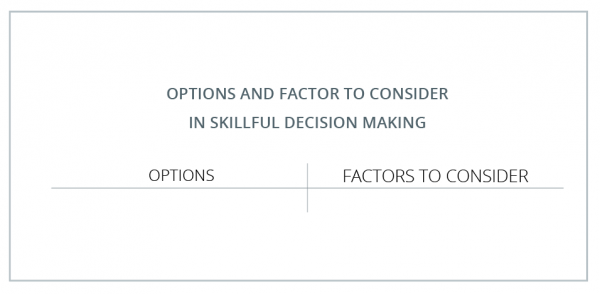
Scaffolding the Collaborative Thinking
The work of the collaborative groups are similarly scaffolded. Rather than asking them just to think together about the issue of energy sources, or even to work on the graphic organizer, she explicitly challenges them with some very specific and focused thinking tasks. For example she may start them thinking about options by saying: “Try to think of as many options as you can and write them on your graphic organizers. And talk together about these,” or she might ask, after they have started: “How many of you have at least five options?”, and then after the students respond, she might add “Well see if you can come up with at least fifteen, including some really original ones.” Typically the students moan, but most of them rise to such challenges.
Here’s a list of options produced in one such class. Notice that it is the result of open brainstorming, not treated as an end in itself but as a component in skillful decision making:
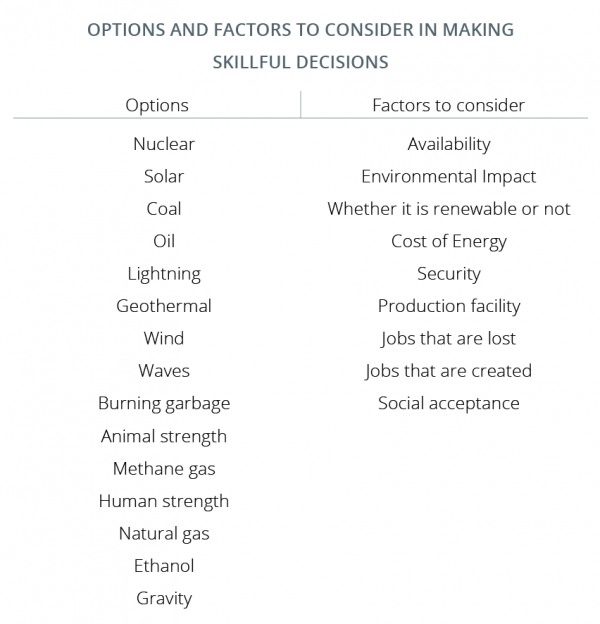
Ms Hagevik recognized that the students have produced a list of a large number of energy sources, some more fanciful than others (though at this stage, in good brainstorming form, all options are treated equally). Once such a list is produced, trying to decide which one is the best one seems a daunting task. So she says “Maybe it will be easier if we approach this now in a more organized way. Let’s see if we can think of a small number of factors that we need to take into account in order to decide which energy source we want to recommend. For example, we should probably consider cost, don’t you agree? What else will we want to take into account? Let’s make a list of these factors in the next column.” Notice how she models this activity. In this case the procedure is quite effective. Here is the list of factors her students produced. Also note that she has obviously paraphrased some of these – use of exact language is something she models as well. This is one of the important habits of mind that she stresses in this lesson to enhance the thinking the students engage in.
This, though, is only a beginning, as we will see in a moment. For now the students have an unprocessed list of possible sources of energy, and a list of things they need to find out about a source of energy to judge how viable it is as the source we should make dominant in this country. So she asks: “What should we do next?”
Many students see that where they should go next is obvious. They need to get information about to what degree these factors are present with regard to each energy source, and then compare them, before they can make a choice. So she goes back to the thinking map, which she has posted on the wall on a piece of newsprint. “What is the next question on the thinking map?” Many students repeat the question: “What are the likely consequences of these options?” She continues: “How can we figure out what the consequences of these options are?” She waits for some reflection by the students and then some responses. She gets them. Their upshot is that we can project consequences in each of these categories based on the information they get. When she asks for an example about cost, some students respond immediately that based on what they find out they can project how much it will cost to produce energy via a specific source, for example, they might figure out how much it costs for electricity for their city using solar panels by finding out how much solar panels cost, how many would be needed, and how much it costs to install and maintain them. Ms Hagevik is pleased by such responses – even if not all of the students in the class think of this, when they hear this student’s response she can highlight what he says on the board so that they can all see how this examples relates to the question on the thinking map about consequences.

Finding and Processing Relevant Information
Ms Hagevick now gives the students an adapted matrix as a graphic organizer to use to record and process what they have come up with so far. It looks like this:
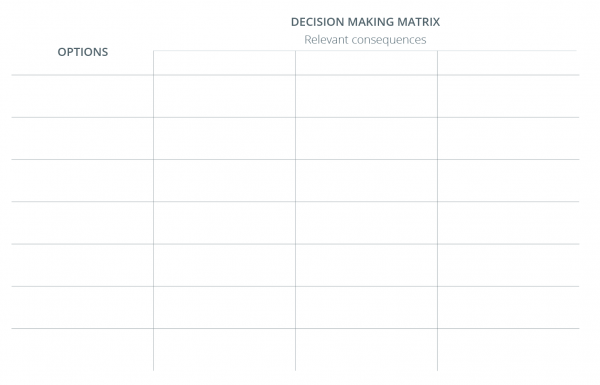
Notice how this graphic organizer is adapted to the process she has engaged them in so far: there is a column for options and a row set aside at the top in which they can record the factors they have identified. She will ask each group to work on just a small number of sources from the list, planning to have them record their results on a large chart on which a larger matrix will be drawn so that all of the students can reap the benefits of the work that each team engages in.
Graphic organizers of this sort are extremely useful in such thinking based activities. They give students a structure which reflects the thinking they are engaging in, and provides places to “download” their thoughts so that they don’t have to keep them in their heads. She wants them to get in the habit of doing this so that they can have a record of the ideas they come up with and can return to them to rethink them in the light of new information. Ms Hagevik has gotten used to using such graphic organizers for each of the types of skillful thinking she teaches her students, and they have gotten used to using them. In fact, they have also gotten in the habit of reflecting on them keeping in mind that special circumstances may make it necessary to modify them. In fact, in Ms Hagevik’s classroom they have an array of these graphics networked into their computers.
Here is one result from this kind of activity.
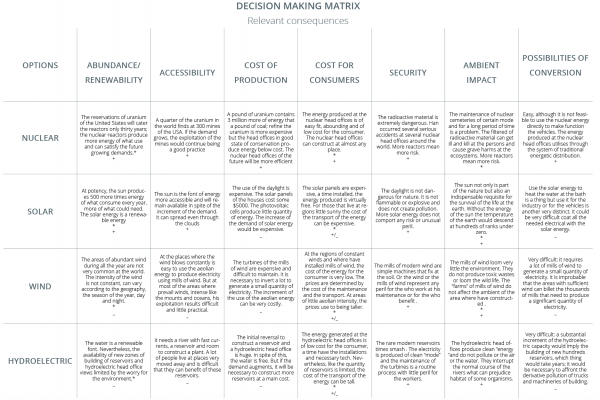
It represents a week’s work gathering information, and then processing it. Note the little “+”s and “-“s in the lower right hand corner. That is a record of discussions in a group about whether the information they have uncovered counts in favor or against the option – is a pro or a con.
This, of course, is a not unfamiliar strategy that is often incorporated into other materials produced for students to help them develop better thinking. In one popular thinking program students, for example, are given a situation and asked what the “plusses” and “minuses” of that situation are. But in these cases such activities are often treated as independent activities and not integrated into any broader more focused thinking activity like skillful decision making. In this case they are.
Note also the “*”s. These, too, indicate judgments that the group has made about the information in the boxes. The stars, in fact, indicate which of these consequences are more important than the others. In fact, this moves the students to the fifth question on the thinking map. Here they are ranking consequences, and they use a two-point scale: more important/less important. Ms Hagevik prompts them to discuss this question for each factor and make sure that they have reasons for assigning stars to these boxes so that if they are challenged they can defend their judgments.
Other teachers have made the task of ranking these consequences somewhat more complex. They have set the scale differently. A teacher could, of course, ask students to rank these consequences on a scale of anything from 1 – 2 to 1 – 10. But just doing this encourages more intuitive and arbitrary ranking. What is important is that the teacher either provide or have the students develop a set of standards on the basis of which they can make these determinations, no matter how finely tuned the scale is. For example, one teacher worked with the students and they developed a scale based on how many people were impacted by the projected consequence and how much harm or benefit would result. This class had unwittingly developed the same scale as used by the famous classical utilitarians in their proposal about how to rank the projected consequences of actions. In Ms Hagevik’s case she suggested potential harm or benefit to others as a standard but intended to take some time later in the school year to focus just in the activity of ranking so that she could help her students develop more skill at this thinking task, and subsequently fold it into subsequent decisionmaking activities they would be engaging in. In the present case she was very sensitive to the issue of the cognitive load on her students if she took the time to do this now.

What is important is that the teacher either provide or have the students develop a set of standards on the basis of which they can make these determinations, no matter how finely tuned the scale is.
My observation of this result – a completed matrix like that above – led to three immediate impressions. The first was how much content learning these completed graphics represented – how much these students have learned about energy, its sources, and the issues the use of these sources generates, much more, for example, than we ever could expect if they just read their textbooks and prepared for tests on the material from their texts. And all in one week!
The second impression was how relatively easy it had now become to narrow down the field of sources, and to settle on one as the best source. You can almost tell at a glance if an energy source is “in the ballpark” or not: if all of the important factors are cons, and that is the trend overall, well, that source has its problems. On the other hand, if they are all pros that’s different. Of course, two or three may well be close competitors, and some deeper thinking might have to be involved to make a choice, but such choices are much more accessible to ordinary students given this way of processing the information gathered than it seems at the outset when this information has not yet been accessed. The third impression is that almost all that students need in order to defend their judgments is contained on these graphic organizers. If challenged with a “Why?” a students can go back to the graphic organizer and find there the material he or she can cite to defend their judgments. “Look,” the student might say, “all of the important factors are plusses, and there is only one minus, a small matter that maybe we can deal with.”
Gathering Relevant Information
So what went on in Ms Hagevik’s classroom between the time the students developed their list of options and the factors to consider and the time they completed these matrices so that they could make a choice?
There are four basic ways that I’ve seen this activity engaged in the classroom. One of them usually doesn’t work well. It is when the teacher asks the students to go back to their texts books and use them to fill in the details. Text books generally are not finely-grained enough and this either becomes a very frustrating activity for the students, or they lose interest in it.
The second way involves the teacher still trying to contain the lesson within the classroom. The teacher can bring supplementary books, articles, material he or she runs off from the internet, and even video tapes and DVDs about energy sources. The teacher should, of course, make sure that the material is extensive enough for students to be able to find the information they need in it.
The third way involves making this a library and/or internet research project. This takes some time, so the teacher must make sure he or she has the time. Finally, again with ample time, the teacher can make the world a resource for the students and tell them that wherever they think they can get such information is fair game: if they want to find out the price of a solar panel they might, for example, find some place that sells them and either telephone or email them asking them questions that will bring back the information they need.
Ms Hagevik combined the third and fourth of these approaches. In fact, she helped each group develop a “research” plan for getting information about the options they were considering, even to the extent that if the group wanted to divide the labor (a pair of students would search the internet, another pair go to the school library, etc.) she helped them develop a plan for doing this.

Certifying the Accuracy of the Information
Ms Hagevik was also careful to focus all of her students on a hazard of doing this. She has already introduced her students to the idea that they could develop a strategy for thinking carefully and skillfully when they were gathering information about how likely it was that the information was reliable by judging the reliability of the source of information. She had introduced them to this thinking map for this kind of skillful thinking, and, in fact, they had practiced it many times.
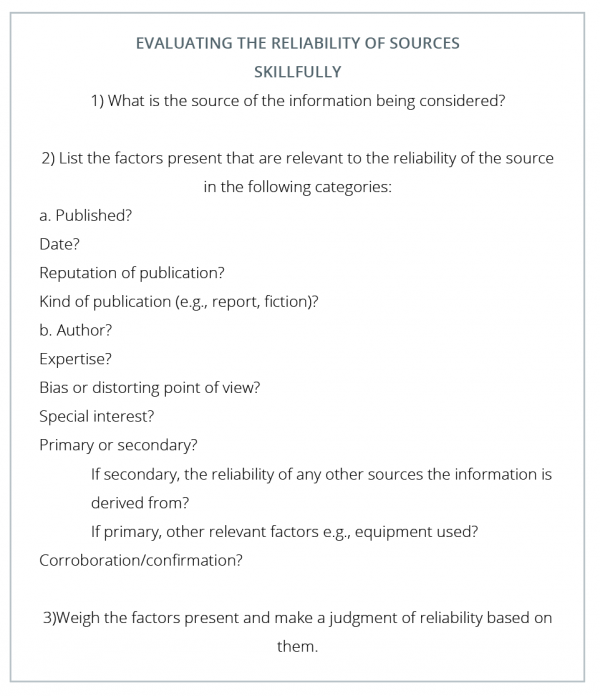
So she cues them to the use of this strategy again by asking whether they can foresee any problems about getting information of the sort they were looking for, for example about some often controversial energy sources like nuclear power. Some of the students picked up on this immediately, remarking that they had to make sure that the information was reliable. She suggested, then, that for any piece of information that they get, they make sure they certify it as likely to be reliable information, and be prepared to defend this when they bring the information back. She suggested that they do this especially with regard to the internet. They did!
From Good Thinking to Good Writing
To round this activity off Ms Hagevik asks her students to do some writing. One of the themes in her classroom all year has been to help her students develop the habit of communicating their ideas with clarity and precision. In this instance she asks them to imagine that they now must give a speech to a congressional committee in which they affirm their recommendation and explain their reasons, showing the committee that they their recommendations are based on careful and thorough thinking.
Often even students who do careful thinking have problems moving their thinking into good writing. Ms Hagevik has adopted a technique used by other teachers to help them get over this barrier: it is to use an explicit format for writing a persuasive speech. It looks like the following:
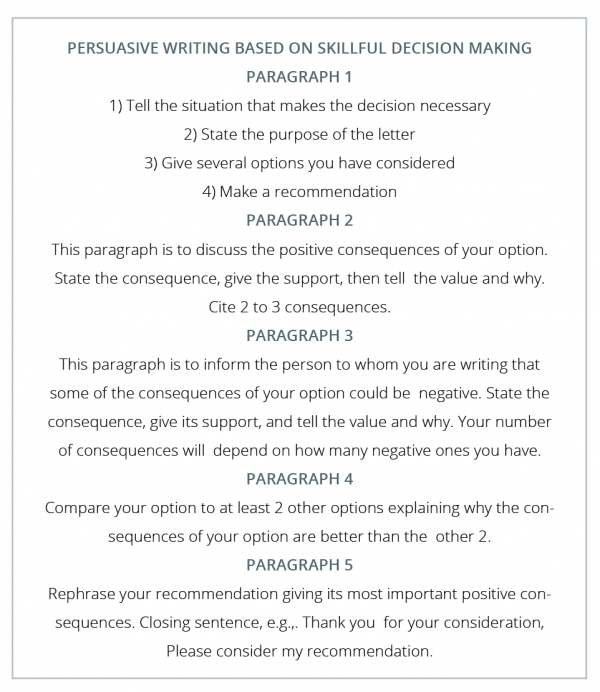
Ms Hagevik had been concerned that this might make her students’ writing into “formula writing”. But after receiving their work she realized that all this template did was to give them a structure. The details, which required deep and careful thinking to formulate, were left to the students.
Many students, indeed, rose to the occasion and produced pieces of writing that they took quite seriously.
Infusing direct instruction in skillful thinking into content instruction
3. Prompting students to articulate, evaluate, and plan their thinking
Ms Hagevik has not completed his unit, however. She had learned, through her staff development activities, that it was important in such infusion lessons, to get the students to stand back from the thinking they were doing that was content-related, and to think about their thinking: to engage in various types of metacognoition leading to their planning how they would do the same type of thinking again when it was called for. For this task she introduced them to a four-step procedure and engaged them in thinking together to share their ideas. The procedure started with the students identifying the kind of thinking they just engaged in, then describing how they did it, and then asking, “Was this a good way to do this kind of thinking?” or “Does the procedure need modification. If so, how, and then, how can this be turned into an explicit plan for doing the same sort of thinking again?”
Students are learning strategies for thinking that will benefit them for the rest of their lives, and as a result their depth of content understanding, interest in the subject matter and retention has increased.

In effect, Ms Hagevik had learned the effectiveness of a certain type of metacognitive strategy which I and my colleagues call elsewhere “going up he ladder of metacognition”. Once the students reach this point Ms Hagevik can then remove some of the scaffolding she has built into this unit and say to the students, as she gives them more practice in skillful decision making, “Use your strategy for skillful decision making to think through this new issue.” She will then be well along that important road that leads to her students internalizing these strategies and processes so that they themselves guide their own thinking by selecting the strategies they are going to use and the mental habits they will display to best serve their thinking needs. And they will do all of that when Ms Hagevik is not around to remind them, just as good football players can size up a situation and make quick decisions about what they will do in the field without their coaches telling them what to do. This, too, turns on prior guided practice just as much as we have outlined makes for good instruction in skillful thinking.
Summary and Conclusion
Rita Hagevik, a 7th grade teacher in an urban middle school, has blended together and made use of many instructional strategies for teaching thinking skills that she may have learned piecemeal, but this time uses within the context of a rich ongoing and coordinated thinking-based learning experience for her students in which she infuses direct instruction in important thinking skills and habits of mind into her content instruction. The result is their presentation of informed and well supported ideas about an important topic in the curriculum, and the ongoing development of these thinking skills and mental habits.
What Ms. Hagevik has done is typical of many other teachers teaching at different grade levels, in different subject areas, focusing on different thinking skills and habits of mind, all in the context of the regular curriculum in their schools, districts, and nations. Still – this only represents a small percentage of classrooms in these schools, school districts, and nations. The instructional model that Rita Hagevik uses, however, is quite accessible to other teachers. Just think about it. Long term, her students are learning strategies for thinking that will benefit them for the rest of their lives. And in the course of this the depth of their content understanding, their interest in the subjects they are learning, and their retention has been increased dramatically.
To me, this is education as it should be.
Related to: Article
You might also like



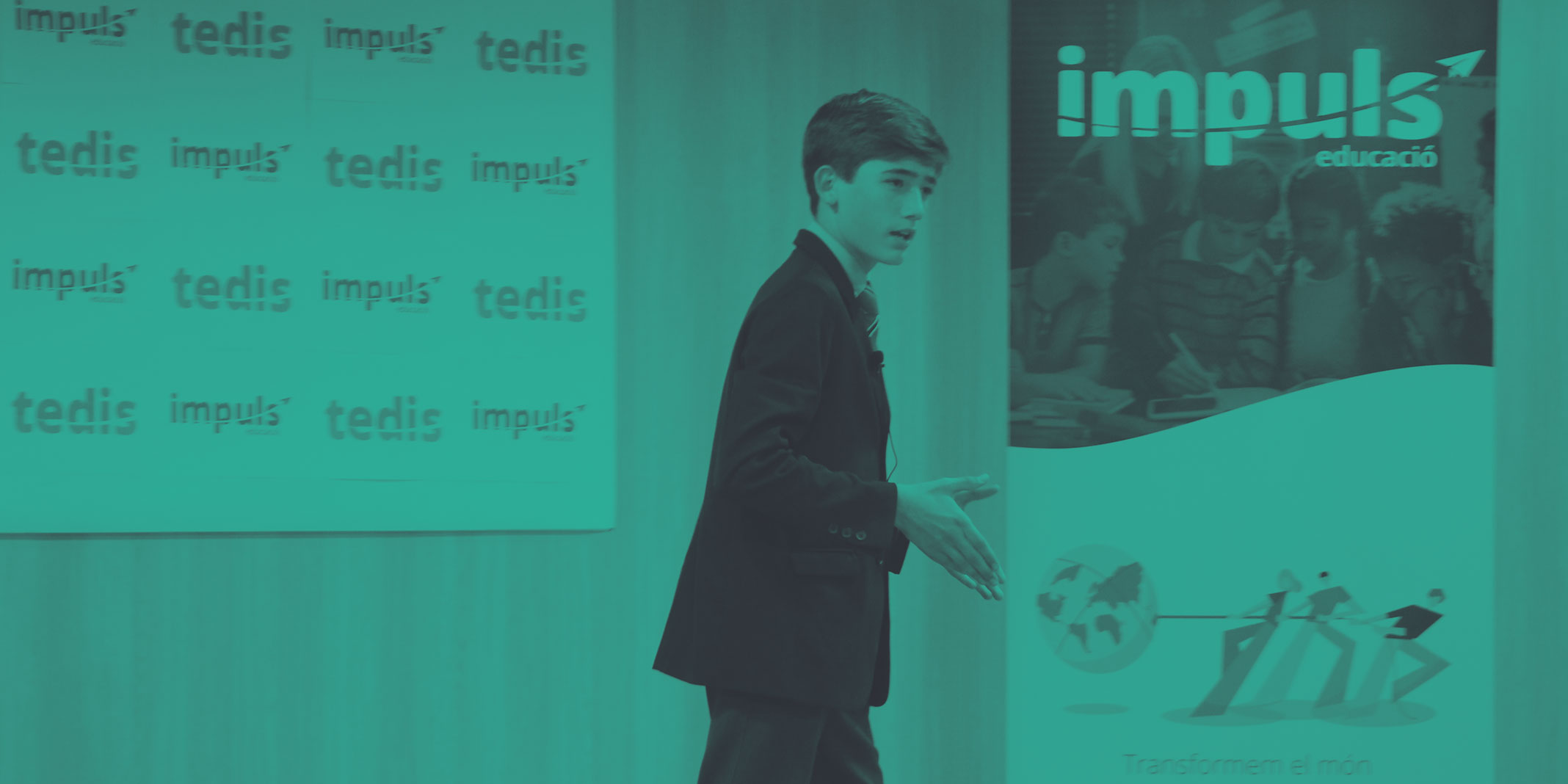


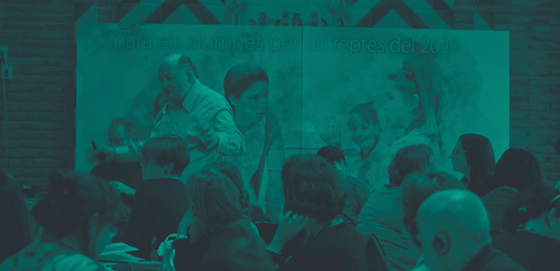


Leave A Comment